Reducing Youth Crime and Deviance: A Briefing Note on Policy Options
VerifiedAdded on 2022/08/22
|6
|1482
|31
Report
AI Summary
This briefing note, prepared by a student and available on Desklib, addresses the critical issue of youth crime. It defines youth crime as offenses committed by individuals under 18 and identifies key contributing factors such as family background, social influence, financial issues, and mental health problems. The note highlights relevant legislation, including the Crime and Disorder Act, Sentencing Act, and others, designed to regulate and control youth crime. The report then proposes several recommendations to reduce youth crime, including educational programs to raise awareness, reinforcement of law enforcement agencies, a planned approach that considers the behavioral aspects of each child, and restricting the availability of drugs. The conclusion emphasizes the importance of proactive measures to secure the future of youth and, consequently, the nation, advocating for the implementation of the suggested recommendations to address the challenges of youth crime.
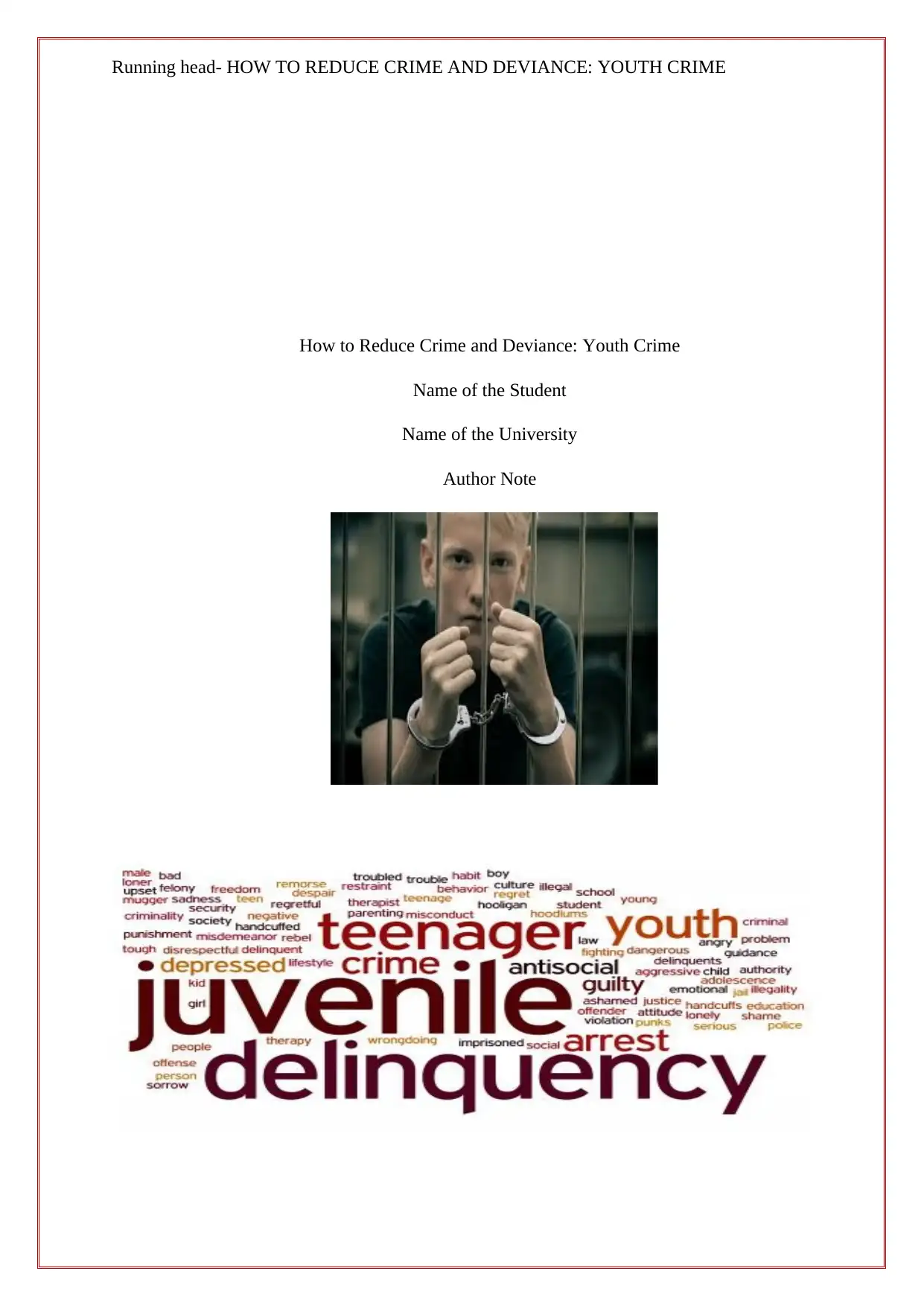
Running head- HOW TO REDUCE CRIME AND DEVIANCE: YOUTH CRIME
How to Reduce Crime and Deviance: Youth Crime
Name of the Student
Name of the University
Author Note
How to Reduce Crime and Deviance: Youth Crime
Name of the Student
Name of the University
Author Note
Paraphrase This Document
Need a fresh take? Get an instant paraphrase of this document with our AI Paraphraser
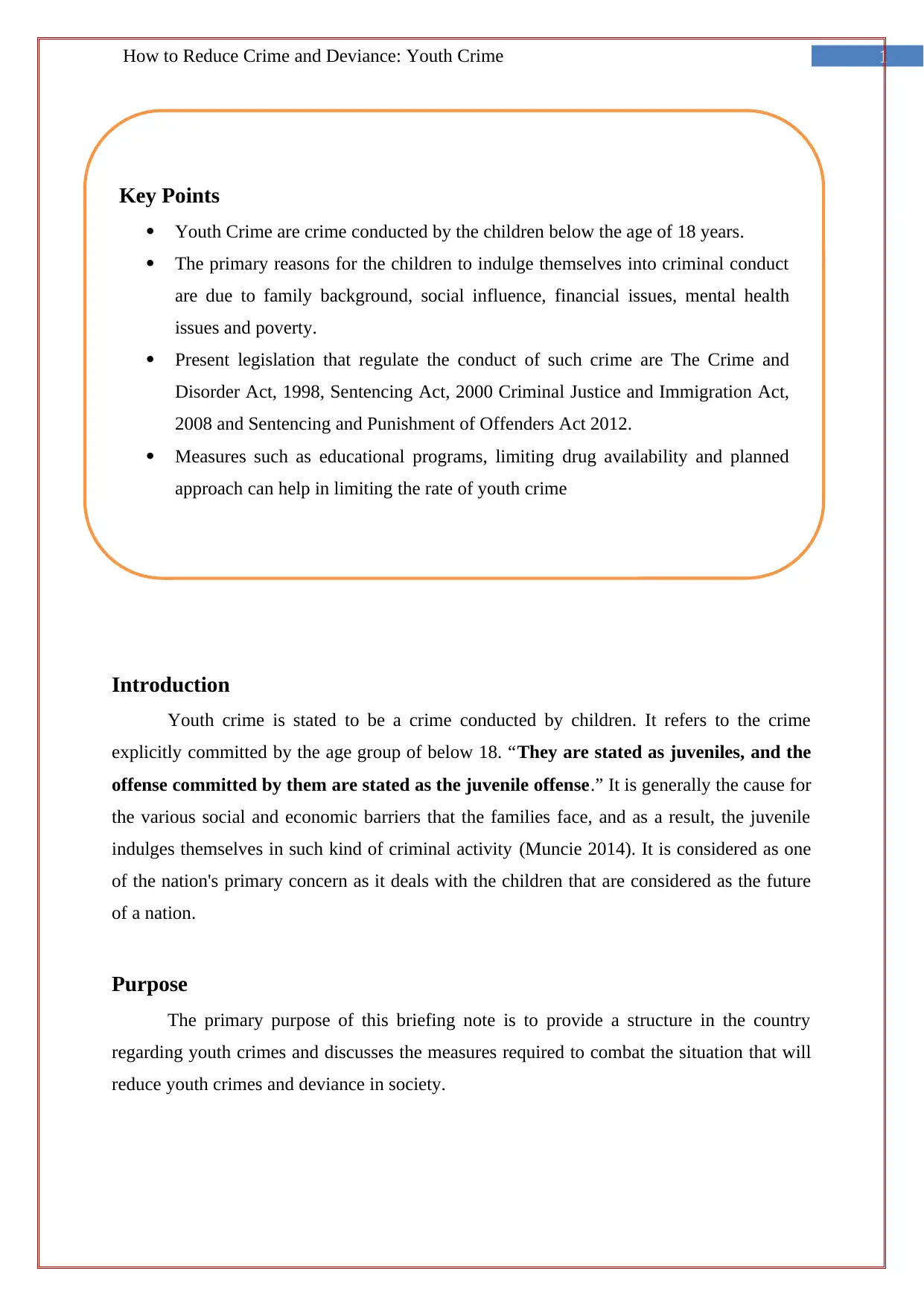
1How to Reduce Crime and Deviance: Youth Crime
Introduction
Youth crime is stated to be a crime conducted by children. It refers to the crime
explicitly committed by the age group of below 18. “They are stated as juveniles, and the
offense committed by them are stated as the juvenile offense.” It is generally the cause for
the various social and economic barriers that the families face, and as a result, the juvenile
indulges themselves in such kind of criminal activity (Muncie 2014). It is considered as one
of the nation's primary concern as it deals with the children that are considered as the future
of a nation.
Purpose
The primary purpose of this briefing note is to provide a structure in the country
regarding youth crimes and discusses the measures required to combat the situation that will
reduce youth crimes and deviance in society.
Key Points
Youth Crime are crime conducted by the children below the age of 18 years.
The primary reasons for the children to indulge themselves into criminal conduct
are due to family background, social influence, financial issues, mental health
issues and poverty.
Present legislation that regulate the conduct of such crime are The Crime and
Disorder Act, 1998, Sentencing Act, 2000 Criminal Justice and Immigration Act,
2008 and Sentencing and Punishment of Offenders Act 2012.
Measures such as educational programs, limiting drug availability and planned
approach can help in limiting the rate of youth crime
Introduction
Youth crime is stated to be a crime conducted by children. It refers to the crime
explicitly committed by the age group of below 18. “They are stated as juveniles, and the
offense committed by them are stated as the juvenile offense.” It is generally the cause for
the various social and economic barriers that the families face, and as a result, the juvenile
indulges themselves in such kind of criminal activity (Muncie 2014). It is considered as one
of the nation's primary concern as it deals with the children that are considered as the future
of a nation.
Purpose
The primary purpose of this briefing note is to provide a structure in the country
regarding youth crimes and discusses the measures required to combat the situation that will
reduce youth crimes and deviance in society.
Key Points
Youth Crime are crime conducted by the children below the age of 18 years.
The primary reasons for the children to indulge themselves into criminal conduct
are due to family background, social influence, financial issues, mental health
issues and poverty.
Present legislation that regulate the conduct of such crime are The Crime and
Disorder Act, 1998, Sentencing Act, 2000 Criminal Justice and Immigration Act,
2008 and Sentencing and Punishment of Offenders Act 2012.
Measures such as educational programs, limiting drug availability and planned
approach can help in limiting the rate of youth crime
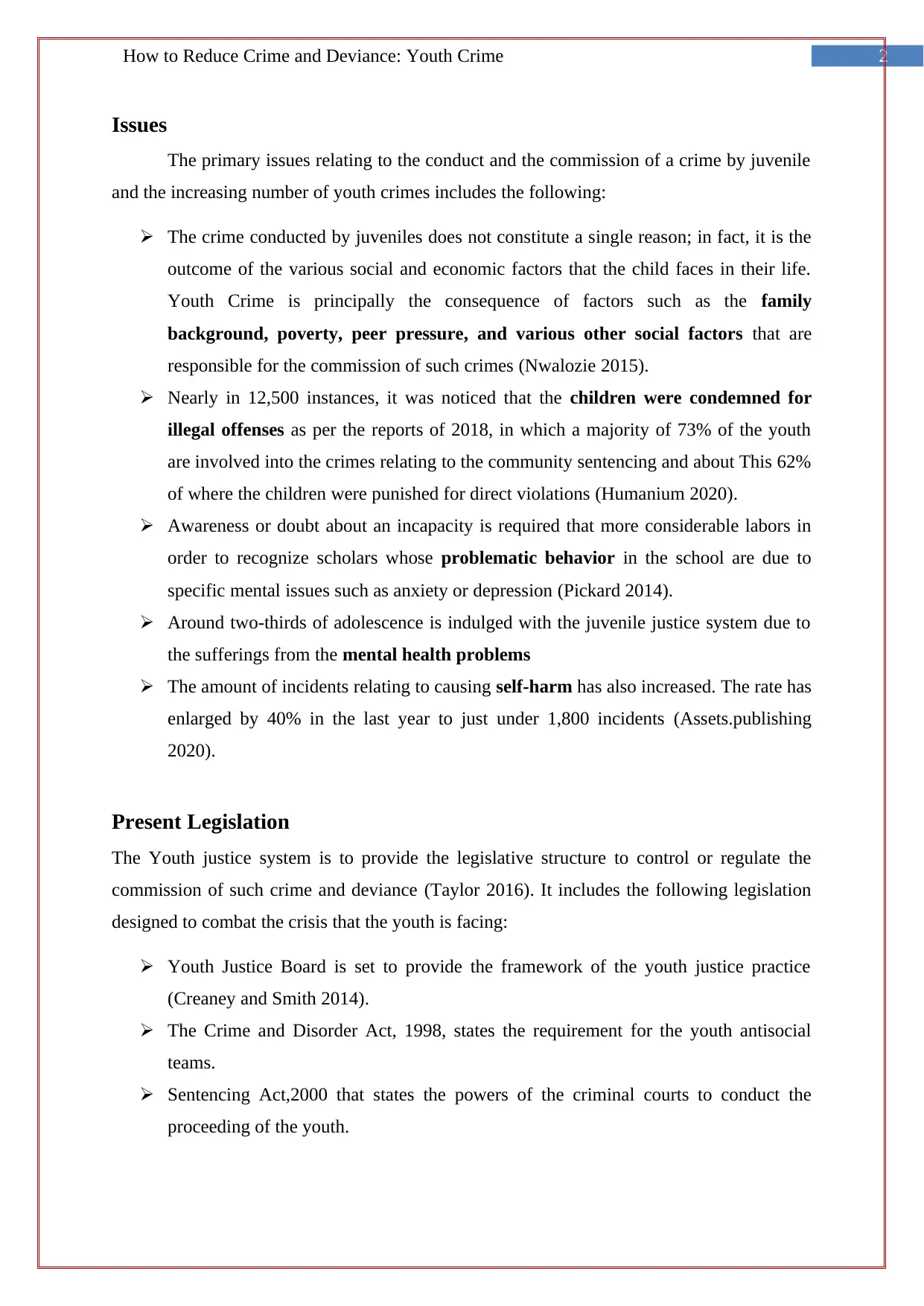
2How to Reduce Crime and Deviance: Youth Crime
Issues
The primary issues relating to the conduct and the commission of a crime by juvenile
and the increasing number of youth crimes includes the following:
The crime conducted by juveniles does not constitute a single reason; in fact, it is the
outcome of the various social and economic factors that the child faces in their life.
Youth Crime is principally the consequence of factors such as the family
background, poverty, peer pressure, and various other social factors that are
responsible for the commission of such crimes (Nwalozie 2015).
Nearly in 12,500 instances, it was noticed that the children were condemned for
illegal offenses as per the reports of 2018, in which a majority of 73% of the youth
are involved into the crimes relating to the community sentencing and about This 62%
of where the children were punished for direct violations (Humanium 2020).
Awareness or doubt about an incapacity is required that more considerable labors in
order to recognize scholars whose problematic behavior in the school are due to
specific mental issues such as anxiety or depression (Pickard 2014).
Around two-thirds of adolescence is indulged with the juvenile justice system due to
the sufferings from the mental health problems
The amount of incidents relating to causing self-harm has also increased. The rate has
enlarged by 40% in the last year to just under 1,800 incidents (Assets.publishing
2020).
Present Legislation
The Youth justice system is to provide the legislative structure to control or regulate the
commission of such crime and deviance (Taylor 2016). It includes the following legislation
designed to combat the crisis that the youth is facing:
Youth Justice Board is set to provide the framework of the youth justice practice
(Creaney and Smith 2014).
The Crime and Disorder Act, 1998, states the requirement for the youth antisocial
teams.
Sentencing Act,2000 that states the powers of the criminal courts to conduct the
proceeding of the youth.
Issues
The primary issues relating to the conduct and the commission of a crime by juvenile
and the increasing number of youth crimes includes the following:
The crime conducted by juveniles does not constitute a single reason; in fact, it is the
outcome of the various social and economic factors that the child faces in their life.
Youth Crime is principally the consequence of factors such as the family
background, poverty, peer pressure, and various other social factors that are
responsible for the commission of such crimes (Nwalozie 2015).
Nearly in 12,500 instances, it was noticed that the children were condemned for
illegal offenses as per the reports of 2018, in which a majority of 73% of the youth
are involved into the crimes relating to the community sentencing and about This 62%
of where the children were punished for direct violations (Humanium 2020).
Awareness or doubt about an incapacity is required that more considerable labors in
order to recognize scholars whose problematic behavior in the school are due to
specific mental issues such as anxiety or depression (Pickard 2014).
Around two-thirds of adolescence is indulged with the juvenile justice system due to
the sufferings from the mental health problems
The amount of incidents relating to causing self-harm has also increased. The rate has
enlarged by 40% in the last year to just under 1,800 incidents (Assets.publishing
2020).
Present Legislation
The Youth justice system is to provide the legislative structure to control or regulate the
commission of such crime and deviance (Taylor 2016). It includes the following legislation
designed to combat the crisis that the youth is facing:
Youth Justice Board is set to provide the framework of the youth justice practice
(Creaney and Smith 2014).
The Crime and Disorder Act, 1998, states the requirement for the youth antisocial
teams.
Sentencing Act,2000 that states the powers of the criminal courts to conduct the
proceeding of the youth.
⊘ This is a preview!⊘
Do you want full access?
Subscribe today to unlock all pages.

Trusted by 1+ million students worldwide
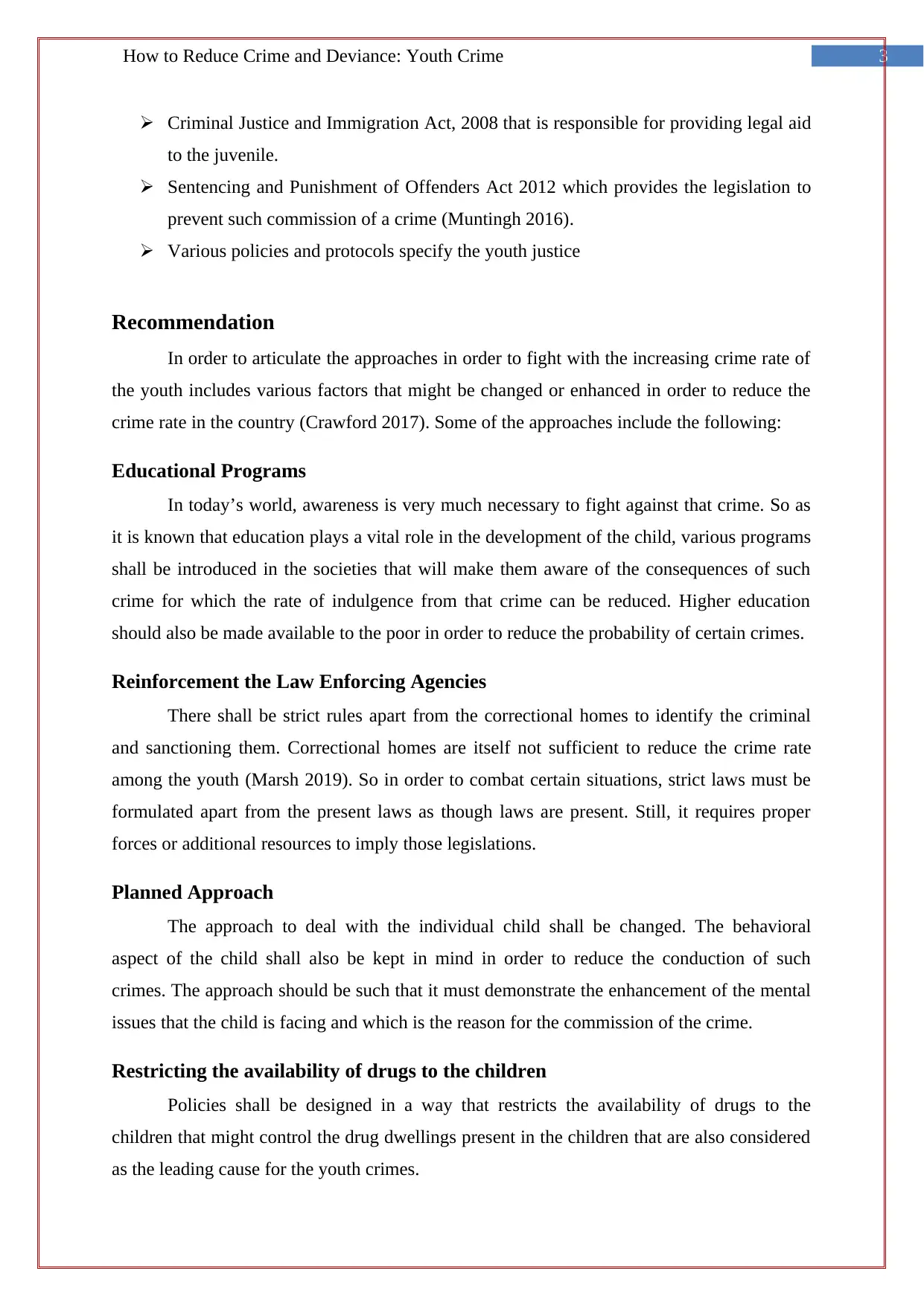
3How to Reduce Crime and Deviance: Youth Crime
Criminal Justice and Immigration Act, 2008 that is responsible for providing legal aid
to the juvenile.
Sentencing and Punishment of Offenders Act 2012 which provides the legislation to
prevent such commission of a crime (Muntingh 2016).
Various policies and protocols specify the youth justice
Recommendation
In order to articulate the approaches in order to fight with the increasing crime rate of
the youth includes various factors that might be changed or enhanced in order to reduce the
crime rate in the country (Crawford 2017). Some of the approaches include the following:
Educational Programs
In today’s world, awareness is very much necessary to fight against that crime. So as
it is known that education plays a vital role in the development of the child, various programs
shall be introduced in the societies that will make them aware of the consequences of such
crime for which the rate of indulgence from that crime can be reduced. Higher education
should also be made available to the poor in order to reduce the probability of certain crimes.
Reinforcement the Law Enforcing Agencies
There shall be strict rules apart from the correctional homes to identify the criminal
and sanctioning them. Correctional homes are itself not sufficient to reduce the crime rate
among the youth (Marsh 2019). So in order to combat certain situations, strict laws must be
formulated apart from the present laws as though laws are present. Still, it requires proper
forces or additional resources to imply those legislations.
Planned Approach
The approach to deal with the individual child shall be changed. The behavioral
aspect of the child shall also be kept in mind in order to reduce the conduction of such
crimes. The approach should be such that it must demonstrate the enhancement of the mental
issues that the child is facing and which is the reason for the commission of the crime.
Restricting the availability of drugs to the children
Policies shall be designed in a way that restricts the availability of drugs to the
children that might control the drug dwellings present in the children that are also considered
as the leading cause for the youth crimes.
Criminal Justice and Immigration Act, 2008 that is responsible for providing legal aid
to the juvenile.
Sentencing and Punishment of Offenders Act 2012 which provides the legislation to
prevent such commission of a crime (Muntingh 2016).
Various policies and protocols specify the youth justice
Recommendation
In order to articulate the approaches in order to fight with the increasing crime rate of
the youth includes various factors that might be changed or enhanced in order to reduce the
crime rate in the country (Crawford 2017). Some of the approaches include the following:
Educational Programs
In today’s world, awareness is very much necessary to fight against that crime. So as
it is known that education plays a vital role in the development of the child, various programs
shall be introduced in the societies that will make them aware of the consequences of such
crime for which the rate of indulgence from that crime can be reduced. Higher education
should also be made available to the poor in order to reduce the probability of certain crimes.
Reinforcement the Law Enforcing Agencies
There shall be strict rules apart from the correctional homes to identify the criminal
and sanctioning them. Correctional homes are itself not sufficient to reduce the crime rate
among the youth (Marsh 2019). So in order to combat certain situations, strict laws must be
formulated apart from the present laws as though laws are present. Still, it requires proper
forces or additional resources to imply those legislations.
Planned Approach
The approach to deal with the individual child shall be changed. The behavioral
aspect of the child shall also be kept in mind in order to reduce the conduction of such
crimes. The approach should be such that it must demonstrate the enhancement of the mental
issues that the child is facing and which is the reason for the commission of the crime.
Restricting the availability of drugs to the children
Policies shall be designed in a way that restricts the availability of drugs to the
children that might control the drug dwellings present in the children that are also considered
as the leading cause for the youth crimes.
Paraphrase This Document
Need a fresh take? Get an instant paraphrase of this document with our AI Paraphraser
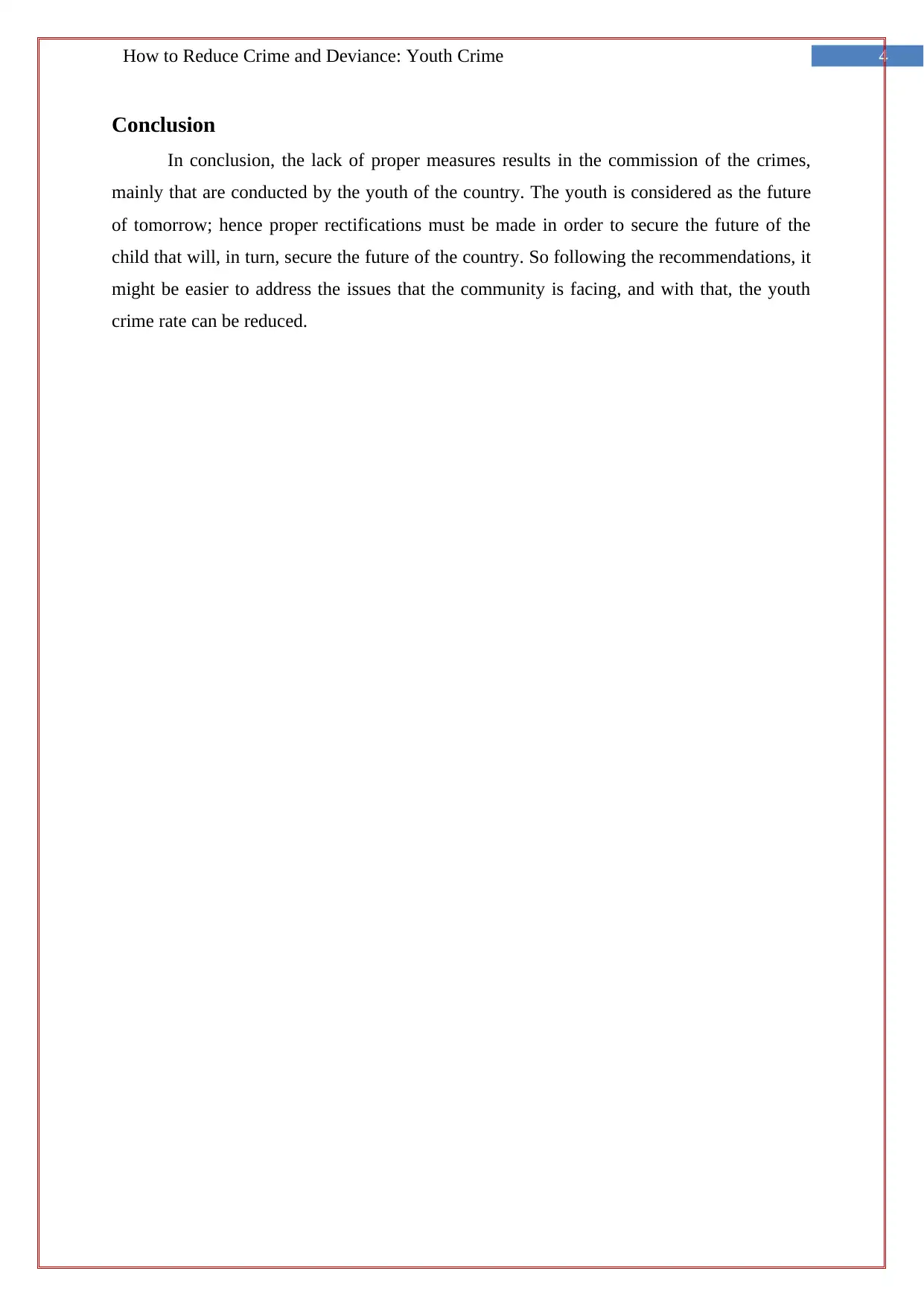
4How to Reduce Crime and Deviance: Youth Crime
Conclusion
In conclusion, the lack of proper measures results in the commission of the crimes,
mainly that are conducted by the youth of the country. The youth is considered as the future
of tomorrow; hence proper rectifications must be made in order to secure the future of the
child that will, in turn, secure the future of the country. So following the recommendations, it
might be easier to address the issues that the community is facing, and with that, the youth
crime rate can be reduced.
Conclusion
In conclusion, the lack of proper measures results in the commission of the crimes,
mainly that are conducted by the youth of the country. The youth is considered as the future
of tomorrow; hence proper rectifications must be made in order to secure the future of the
child that will, in turn, secure the future of the country. So following the recommendations, it
might be easier to address the issues that the community is facing, and with that, the youth
crime rate can be reduced.
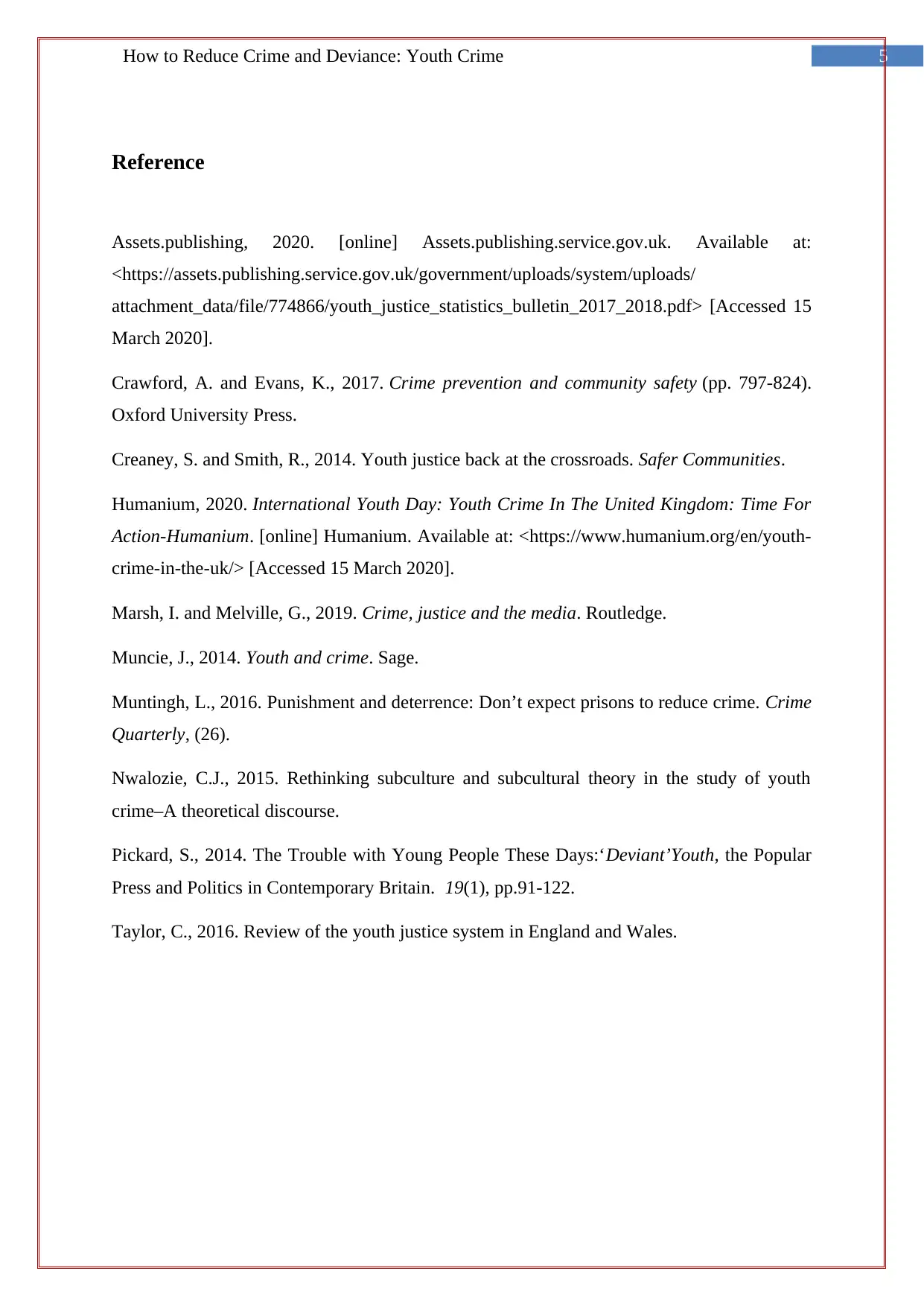
5How to Reduce Crime and Deviance: Youth Crime
Reference
Assets.publishing, 2020. [online] Assets.publishing.service.gov.uk. Available at:
<https://assets.publishing.service.gov.uk/government/uploads/system/uploads/
attachment_data/file/774866/youth_justice_statistics_bulletin_2017_2018.pdf> [Accessed 15
March 2020].
Crawford, A. and Evans, K., 2017. Crime prevention and community safety (pp. 797-824).
Oxford University Press.
Creaney, S. and Smith, R., 2014. Youth justice back at the crossroads. Safer Communities.
Humanium, 2020. International Youth Day: Youth Crime In The United Kingdom: Time For
Action-Humanium. [online] Humanium. Available at: <https://www.humanium.org/en/youth-
crime-in-the-uk/> [Accessed 15 March 2020].
Marsh, I. and Melville, G., 2019. Crime, justice and the media. Routledge.
Muncie, J., 2014. Youth and crime. Sage.
Muntingh, L., 2016. Punishment and deterrence: Don’t expect prisons to reduce crime. Crime
Quarterly, (26).
Nwalozie, C.J., 2015. Rethinking subculture and subcultural theory in the study of youth
crime–A theoretical discourse.
Pickard, S., 2014. The Trouble with Young People These Days:‘Deviant’Youth, the Popular
Press and Politics in Contemporary Britain. 19(1), pp.91-122.
Taylor, C., 2016. Review of the youth justice system in England and Wales.
Reference
Assets.publishing, 2020. [online] Assets.publishing.service.gov.uk. Available at:
<https://assets.publishing.service.gov.uk/government/uploads/system/uploads/
attachment_data/file/774866/youth_justice_statistics_bulletin_2017_2018.pdf> [Accessed 15
March 2020].
Crawford, A. and Evans, K., 2017. Crime prevention and community safety (pp. 797-824).
Oxford University Press.
Creaney, S. and Smith, R., 2014. Youth justice back at the crossroads. Safer Communities.
Humanium, 2020. International Youth Day: Youth Crime In The United Kingdom: Time For
Action-Humanium. [online] Humanium. Available at: <https://www.humanium.org/en/youth-
crime-in-the-uk/> [Accessed 15 March 2020].
Marsh, I. and Melville, G., 2019. Crime, justice and the media. Routledge.
Muncie, J., 2014. Youth and crime. Sage.
Muntingh, L., 2016. Punishment and deterrence: Don’t expect prisons to reduce crime. Crime
Quarterly, (26).
Nwalozie, C.J., 2015. Rethinking subculture and subcultural theory in the study of youth
crime–A theoretical discourse.
Pickard, S., 2014. The Trouble with Young People These Days:‘Deviant’Youth, the Popular
Press and Politics in Contemporary Britain. 19(1), pp.91-122.
Taylor, C., 2016. Review of the youth justice system in England and Wales.
⊘ This is a preview!⊘
Do you want full access?
Subscribe today to unlock all pages.

Trusted by 1+ million students worldwide
1 out of 6
Related Documents
Your All-in-One AI-Powered Toolkit for Academic Success.
+13062052269
info@desklib.com
Available 24*7 on WhatsApp / Email
![[object Object]](/_next/static/media/star-bottom.7253800d.svg)
Unlock your academic potential
Copyright © 2020–2025 A2Z Services. All Rights Reserved. Developed and managed by ZUCOL.




